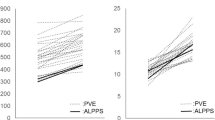Abstract
Background
Technetium-99m-galactosyl human serum albumin (GSA) scintigraphy provides an accurate estimation of the hepatic functional reserve but is not applied after a hepatectomy. The aim of this study was to elucidate the natural course of the remnant hepatic functional reserve (RHFR) after hepatectomy by GSA scintigraphy.
Methods
Eighty-six patients (partial hepatic resection, Hr0 = 46; sectionectomy, Hr1 = 21; bisectionectomy, Hr2 = 19) classified as Child–Pugh class A before the hepatectomy were enrolled, and GSA scintigraphy to detect HH15 (uptake ratio of the heart at 15 min to that at 3 min) and LHL15 (uptake ratio of the liver at 15 min to the liver plus the heart at 15 min) was performed periodically before and after the hepatectomy. HH15, LHL15, and the percentages of patients that recovered to the preoperative levels of these entities were estimated. In addition, hematobiochemical tests and the remnant liver volume were also periodically monitored.
Results
HH15 and LHL15 levels deteriorated until 2 months postoperatively (PO) after the procedure and subsequently recovered to the preoperative levels at 6 months PO in Hr0 patients. In Hr1 patients, but not in Hr2 patients, these levels also deteriorated until 3 months PO and had improved by 6 months after the surgery. Only 40% of the patients showed recovery to the preoperative levels by 6 months PO in the Hr0 group; furthermore, the percentage of patients who showed recovery to the preoperative levels by 6 months PO was under 40% in the Hr1 group and around 10% in the Hr2 group. However, the results of hematobiochemical tests and the remnant liver volume in all types of hepatectomies were rapidly normalized after the hepatectomy.
Conclusions
Remnant hepatic functional reserve estimated by GSA scintigraphy revealed that a larger resected liver volume induced both more serious and continued remnant hepatic dysfunction in comparison to results shown by hematobiochemical tests, while the functional regeneration was also appreciably slower and more gradual in comparison to the volume regeneration.





Similar content being viewed by others
References
Jones SM, Roh MS. Results of surgical resection for hepatocellular carcinoma. Cancer Treat Res. 2001;109:59–75.
Pedersen IK, Burcharth F, Roikjaer O, Baden H. Resection of liver metastases from colorectal cancer. Indications and results. Dis Colon Rectum. 1994;37:1078–82.
Jiao LR, Navarra G, Weber JC, Havlik R, Nicholls JP, Habib NA. Radiofrequency assisted liver resection—a novel technique. Hepatogastroenterology. 2005;52:1685–7.
Hotta T, Kobayashi Y, Taniguchi K, Johata K, Sahara M, Naka T, et al. Evaluation of postoperative nutritional state after hepatectomy for hepatocellular carcinoma. Hepatogastroenterology. 2003;50:1511–6.
Shinomi S. Evaluation of hepatic functional reserve by scintigraphy with (99m) Tc-GSA. Hepatol Res. 2005;31:124–6.
Schneider PD. Preoperative assessment of liver function. Surg Clin North Am. 2004;84:355–73.
Kadono J, Kumemura H, Nishida S, Nakamura N, Gejima K, Makajo K, et al. 99mTc-DTPA-galactosyl-human-serum-albumin liver scintigraphy for evaluating hepatic functional reserve before hepatectomy in a patient with indocyanine green excretory defect: report of a case. Surg Today. 2006;36:481–4.
Nanashima A, Yamaguchi H, Shibasaki S, Morino S, Ide N, Takeshita H, et al. Relationship between indocyanine green test and technetium-99m galactosyl serum albumin scintigraphy in patients scheduled for hepatectomy: clinical evaluation and patient outcome. Hepatol Res. 2004;28:184–90.
Kawamura E, Shinomi S, Ishizu H, Torii K, Kawabe J, Habu D, et al. Natural course of changes in hepatic functional reserve in patients with chronic liver diseases evaluated by scintigraphy with GSA. Hepatol Res. 2003;27:129–35.
Haga J, Shimazu M, Wakabayashi G, Tanabe M, Kawachi S, Fuchimoto Y, et al. Liver regeneration in donors and adult recipients after living donor liver transplantation. Liver Transplant. 2008;14:1718–24.
Kwon AH, Matsui Y, Kaibori M, Kamiyama Y. Functional hepatic regeneration following hepatectomy using galactosyl-human serum albumin liver scintigraphy. Transplant Proc. 2004;36:2257–60.
Author information
Authors and Affiliations
Corresponding author
Rights and permissions
About this article
Cite this article
Shimizu, Y., Aoki, T., Kusano, T. et al. Natural course of the remnant hepatic functional reserve as estimated by technetium-99m-galactosyl human serum albumin scintigraphy after a hepatectomy. J Gastroenterol 45, 308–316 (2010). https://doi.org/10.1007/s00535-009-0144-5
Received:
Accepted:
Published:
Issue Date:
DOI: https://doi.org/10.1007/s00535-009-0144-5




